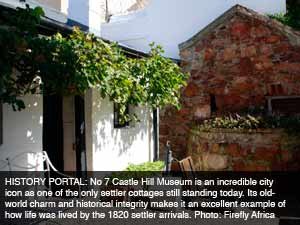King of the Castle Hill
30 March 2012

Between the Feather Market Hall and The Athenaeum, lies a time portal to the unaltered encapsulation of settler life. Built in 1830, No 7 Castle Hill is one of the oldest surviving settler cottages in the city and hence the reason it was voted in as one of Nelson Mandela Bay’s Top 10 icons. In 1965 it was renovated into a museum in an effort to preserve its integrity.
“A visitor can absorb the wonderful ambience of days gone by and marvel at the very organised and industrious life enjoyed at the time. It is the only house museum in South Africa that manages to capture this period - which makes it unique,” said Grizel Hart, No & Castle Hill museum curator.
The house is the oldest dwelling in Nelson Mandela Bay still in its original state. Reverend Francis McClelan built it for his wife and their 11 children after purchasing the land for three pounds and three shillings.
The museum is set out as a home representing domestic life between 1840 and 1870.
“As one of two museums in the Top 10 city icons, each with their own charms, No 7 Castle Hill certainly exposes the every day lives of the early settlers’ years in the city. It is important for us remember and treasure the diverse heritages in the city, said Titus Chuene, marketing manager of the NMBT. “The other museum in the Top 10 is Red Location Museum, and it also captures a different but equally important heritage.”
In the heart of the historical and heritage district of Nelson Mandela Bay, No 7 Castle Hill might just look like an old Victorian house from the outside, but stepping inside takes visitors on a wistful ride down memory lane. It repaints the domestic life of the middle class 19th century British settlers complete with yellowwood floors and beams, a vintage dollhouse, lace displays and downstairs kitchen and hearth.
“Our city is home to a great heritage selection, with some of the country’s oldest buildings still standing. No 7 Castle Hill is the only museum where you can go to experience the surroundings of how the settlers lived back then,” said Pierre Voges, Mandela Bay Development Agency (MBDA) chief executive.
There are many interesting items on display for your enjoyment, including a toy museum with a wonderful collection of antique dolls and other old toys. The front parlour and dining room recreate the elegance of the times. A few articles in the museum belonged to the original family, including the dining room table and chairs.
The kitchen in the basement has the original Bak-oond. Transporting some, older, visitors back to their childhood. There is an old wood stove, a manual washing machine and a very clever peach-peeler amongst many other interesting items.
The original well is still working in the cobbled courtyard, bearing testament to the engineering expertise of the settlers. “The well in the courtyard is original and acts as an underground 'tank'. It is made of the same sandstone as the house. Water is siphoned off the roof down gutters, into the well. The pump is dated 1849 and still works. The vine in the courtyard is beautiful and produces wonderful grapes,” said Hart of her caught-in-time museum.
“No 7 Castle Hill truly captures the ‘old’ Port Elizabeth in the ambience of the building’s interior and exterior. I could not be happier to call it one of the city’s top 10 icons. When you visit, you are sure to leave just a little more enchanted than when you arrived,” said Chuene.
Opening times are Monday to Thursday 10am to 4.30pm. On Fridays the museum opens between 10am to 4pm, closed from 1pm to 2pm.





















 Please wait!
Please wait!